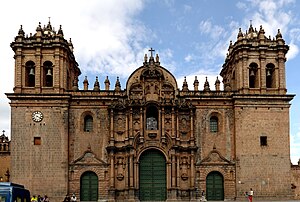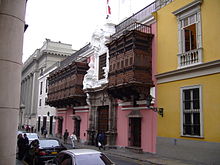20:
127:
43:
142:
161:
326:
crown as well as native flora and fauna (Arequipa papayas and the
Chiguanco thrush). It was created by primarily by indigenous sculptors, sometimes inspired by textile patterns. The new style appeared primarily on the stone carved facades of churches and palaces, first in
110:
Early academia has tended to view the
Spanish architectural and religious takeover as complete and swift, but revisionist history emphasizes the lasting role of the indigenous in religious architecture.
191:. This style was characterized by the use of ornaments and watermarks that were giving away the architectural lines of the building's likeness chiseled work of silver, hence the name
107:
between the 16th and 19th centuries, was characterized by the importation and adaptation of
European architectural styles to the Peruvian reality, yielding an original architecture.
508:
335:
region and further south to Oruro and even into Chile. It was one of the most vigorous combinations of styles in all of colonial Latin
America. The most important buildings are the
362:
231:
was distinguished and characterized by his heavy ornamentation, of predominantly curved lines, giving an aspect of free movement. Predominant decorative elements in
565:
436:(using Romanesque columns with Corinthian capitals and without ornamentation, straight lines and simplicity in them, in addition to triangular frontispiece).
555:
585:
509:
Christopher Wang, "Colonial
Architecture of the Viceroyalty of Peru: The necessary and continued role of the indigenous in Christianity."
388:
In the 18th century, with the introduction of the French
Bourbon dynasty, came to Spain this style that was characterized by non-rounded
279:
86:
64:
570:
456:
255:
243:, and a modification of the classical forms, the Greek columns lose their purity to wring, as thick snakes, its trunks to form
207:
of the colonial period, from the 16th to mid-17th century. These are magnificent examples of this style in Lima facades of the
118:, the ornamentation of Andean iconography and solutions to give new forms to Peruvian viceroyal architecture an own identity.
357:
and distinguished by the use of complicated and whimsical ornaments exaggerated, his advocate was a
Spanish architect named
575:
560:
490:
392:, the decrease of ornaments in the ornamentation in columns (these are less twisted) while the characteristics of the
464:
452:
336:
291:
19:
251:
366:
429:
409:
165:
134:
126:
57:
51:
540:
200:
580:
433:
358:
258:. This style prevailed since the middle of the 17th to the late 18th century, subsequently giving rise to
212:
68:
468:
169:
480:
196:
188:
176:
104:
432:, which was characterized by the dominance of a trend towards the return of the classic styles of
271:
149:
485:
448:
389:
208:
130:
244:
160:
401:
348:
259:
23:
460:
417:
413:
283:
141:
27:
549:
332:
315:
302:
During the late seventeenth and eighteenth century in the southern Andes (Southern
361:. These are magnificent examples of this style in Lima the facade of churches of
323:
204:
192:
180:
31:
522:
The Andean Hybrid
Baroque: Convergent Cultures in the Churches of Colonial Peru
153:
536:
16:
Architectural style combining
European styles with the local Peruvian reality
328:
287:
236:
216:
310:) a new style developed which blended European Baroque with indigenous (
440:
405:
393:
354:
319:
307:
240:
232:
228:
145:
115:
397:
380:
263:
184:
396:
are the use of curves and undulating lines. The characteristics of
444:
275:
159:
140:
125:
311:
303:
267:
428:
In the late 18th and early 19th century came the style called
36:
219:
the facades of the churches of San
Francisco and La Merced.
286:), the churches of Santo Domingo and San Sebastián. In
274:, the churches of San Francisco and San Marcelo. In
443:. These are magnificent examples of this style the
266:. There are representative examples of Baroque in
250:A characteristic feature of this style is the
8:
404:, the Casa de Larriva (rococo facade but
247:and ornaments acquired great exuberance.
87:Learn how and when to remove this message
50:This article includes a list of general
18:
501:
566:Spanish Colonial architecture in Peru
457:Basilica and Convent of San Francisco
7:
524:University of Notre Dame Press, 2010
114:The use of building systems as the
56:it lacks sufficient corresponding
14:
469:Presbyter Matías Maestro Cemetery
453:Basilica and Convent of San Pedro
439:It was as a reaction against the
254:that appears on the walls of the
170:Presbyter Matías Maestro Cemetery
256:Monastery of San Francisco, Lima
41:
101:Peruvian colonial architecture
1:
556:Spanish Colonial architecture
537:Colonial Architecture Project
183:style, which had occurred in
491:List of architectural styles
187:following the stream of the
586:Tourist attractions in Peru
363:Nuestra Señora de la Merced
602:
520:Bailey, Gauvin Alexander.
412:(rococo facade Lima), the
346:
137:central doorway and towers
410:Casa de las Trece Monedas
175:In the early days of the
455:, the main altar of the
434:Greco-Roman architecture
571:Architecture in Bolivia
541:Gauvin Alexander Bailey
420:, all located in Lima.
353:It was the most ornate
343:Churrigueresque baroque
318:) features such as the
71:more precise citations.
447:and the towers of the
172:
157:
138:
34:
337:Church of La Compañía
292:Church of La Compañía
195:and where art blends
163:
144:
129:
32:plateresque xiloformo
22:
576:Architecture in Peru
511:Accessed 13.08.2013.
481:Architecture of Peru
451:, the facade of the
339:and Puno Cathedral.
152:, with balconies in
561:Viceroyalty of Peru
465:Fort Santa Catalina
459:, pilasters of the
359:José de Churriguera
189:Italian Renaissance
105:Viceroyalty of Peru
103:, developed in the
424:Neoclassical style
280:Cathedral of Cuzco
272:Torre Tagle Palace
179:was developed the
173:
158:
150:Torre Tagle Palace
139:
35:
24:Cathedral of Cusco
486:Balconies of Lima
449:Cathedral of Lima
331:and later in the
209:Cathedral of Lima
131:Cathedral of Lima
122:Renaissance style
97:
96:
89:
593:
525:
518:
512:
506:
463:, the facade of
322:flower and Inka
245:Solomonic column
164:Central Chapel,
92:
85:
81:
78:
72:
67:this article by
58:inline citations
45:
44:
37:
601:
600:
596:
595:
594:
592:
591:
590:
546:
545:
533:
528:
519:
515:
507:
503:
499:
477:
426:
402:Quinta de Presa
375:
351:
349:Churrigueresque
345:
300:
260:Churrigueresque
225:
213:Casa de Pilatos
168:and octagonal,
124:
93:
82:
76:
73:
63:Please help to
62:
46:
42:
17:
12:
11:
5:
599:
597:
589:
588:
583:
578:
573:
568:
563:
558:
548:
547:
544:
543:
532:
531:External links
529:
527:
526:
513:
500:
498:
495:
494:
493:
488:
483:
476:
473:
461:Osambela House
425:
422:
418:Paseo de Aguas
414:Osambela House
386:
385:
374:
371:
347:Main article:
344:
341:
299:
298:Andean Baroque
296:
284:Andean Baroque
224:
221:
148:facade of the
123:
120:
95:
94:
49:
47:
40:
28:Andean Baroque
15:
13:
10:
9:
6:
4:
3:
2:
598:
587:
584:
582:
581:Colonial Peru
579:
577:
574:
572:
569:
567:
564:
562:
559:
557:
554:
553:
551:
542:
538:
535:
534:
530:
523:
517:
514:
510:
505:
502:
496:
492:
489:
487:
484:
482:
479:
478:
474:
472:
470:
466:
462:
458:
454:
450:
446:
442:
437:
435:
431:
423:
421:
419:
415:
411:
407:
403:
399:
395:
391:
383:
382:
377:
376:
372:
370:
368:
364:
360:
356:
350:
342:
340:
338:
334:
333:Lake Titicaca
330:
325:
321:
317:
313:
309:
305:
297:
295:
293:
289:
285:
281:
277:
273:
269:
265:
261:
257:
253:
248:
246:
242:
238:
234:
230:
223:Baroque style
222:
220:
218:
214:
210:
206:
202:
198:
194:
190:
186:
182:
178:
171:
167:
162:
155:
151:
147:
143:
136:
132:
128:
121:
119:
117:
112:
108:
106:
102:
91:
88:
80:
70:
66:
60:
59:
53:
48:
39:
38:
33:
29:
25:
21:
521:
516:
504:
438:
430:neoclassical
427:
387:
378:
352:
301:
249:
226:
174:
166:neoclassical
113:
109:
100:
98:
83:
74:
55:
367:San Agustín
324:maskaypacha
252:rustication
193:plateresque
181:Renaissance
177:Viceroyalty
135:Renaissance
69:introducing
550:Categories
201:Romanesque
77:March 2024
52:references
406:Granadian
400:are: the
390:balconies
379:See also
237:pilasters
30:style of
475:See also
329:Arequipa
288:Arequipa
241:cornices
217:Ayacucho
211:and the
441:baroque
408:), the
394:baroque
355:Baroque
320:kantuta
308:Bolivia
233:columns
229:Baroque
154:Mudéjar
146:Baroque
116:quincha
65:improve
398:rococo
381:Rococo
373:Rococo
316:Aymara
270:, the
264:Rococo
205:Arabic
197:Gothic
185:Europe
156:style.
54:, but
497:Notes
445:altar
276:Cuzco
215:. In
133:with
467:and
416:and
365:and
312:Inca
306:and
304:Peru
290:the
278:the
268:Lima
262:and
227:The
203:and
99:The
539:by
552::
471:.
369:.
314:,
294:.
239:,
235:,
199:,
26:.
384:.
282:(
90:)
84:(
79:)
75:(
61:.
Text is available under the Creative Commons Attribution-ShareAlike License. Additional terms may apply.



